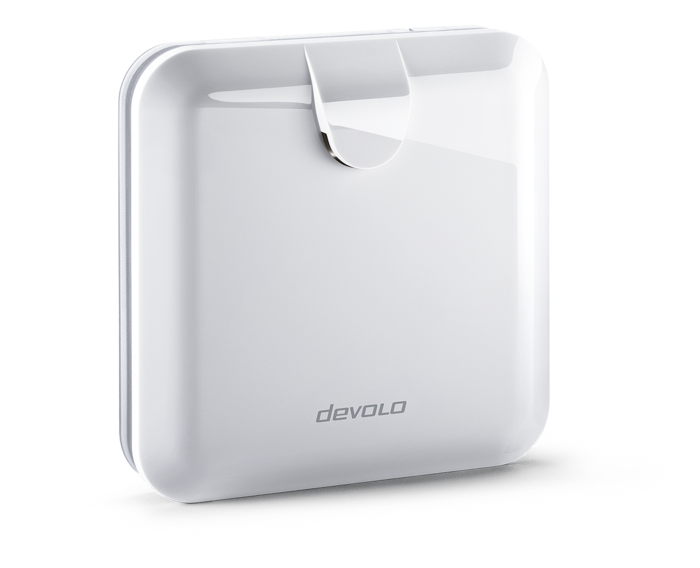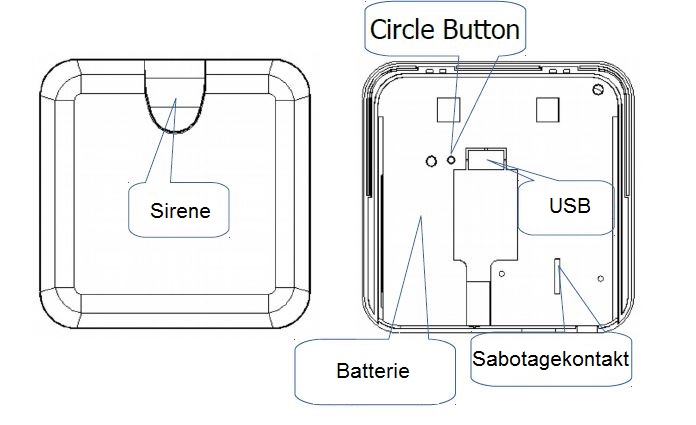
Devolo
Siren
SKU: DEVE9677



Quickstart
This is a
2. Pressing tamper key three times within 1.5 seconds to enter the inclusion mode.
3. After add successful, the LED will light ON 1 second
Important safety information
Please read this manual carefully. Failure to follow the recommendations in this manual may be dangerous or may violate the law. The manufacturer, importer, distributor and seller shall not be liable for any loss or damage resulting from failure to comply with the instructions in this manual or any other material. Use this equipment only for its intended purpose. Follow the disposal instructions. Do not dispose of electronic equipment or batteries in a fire or near open heat sources.What is Z-Wave?
Z-Wave is the international wireless protocol for communication in the Smart Home. This device is suited for use in the region mentioned in the Quickstart section.
Z-Wave ensures a reliable communication by reconfirming every message (two-way communication) and every mains powered node can act as a repeater for other nodes (meshed network) in case the receiver is not in direct wireless range of the transmitter.
This device and every other certified Z-Wave device can be used together with any other certified Z-Wave device regardless of brand and origin as long as both are suited for the same frequency range.
If a device supports secure communication it will communicate with other devices secure as long as this device provides the same or a higher level of security. Otherwise it will automatically turn into a lower level of security to maintain backward compatibility.
For more information about Z-Wave technology, devices, white papers etc. please refer to www.z-wave.info.
Product Description
Siren MT02758 is a wireless siren, based on Z-Wave technology. It is the Z-Wave plus product, it support the security, OTA... Those newest features of the Z-Wave technology.

Prepare for Installation / Reset
Please read the user manual before installing the product.
In order to include (add) a Z-Wave device to a network it must be in factory default state. Please make sure to reset the device into factory default. You can do this by performing an Exclusion operation as described below in the manual. Every Z-Wave controller is able to perform this operation however it is recommended to use the primary controller of the previous network to make sure the very device is excluded properly from this network.
Reset to factory default
This device also allows to be reset without any involvement of a Z-Wave controller. This procedure should only be used when the primary controller is inoperable.
1. Pressing tamper key four times within 1.5 seconds and do not release the tamper key in the 4 pressed, and the LED will light ON.
2. After 3 seconds the LED will turn OFF, after that within 2 seconds, release the tamper key. If successful, the LED will light ON one second. Otherwise, the LED will flash once.
3. IDs are excluded and all settings will reset to factory default.
Safety Warning for Mains Powered Devices
ATTENTION: only authorized technicians under consideration of the country-specific installation guidelines/norms may do works with mains power. Prior to the assembly of the product, the voltage network has to be switched off and ensured against re-switching.
Installation
Use the Home Control alarm siren only indoors. Ceiling or wall mounting is possible.
The alarm function is switched off when the Home Control alarm siren is delivered. Once the device is added to the home control network, a disassembly alarm is automatically activated, which would be triggered for 3 minutes if the siren is removed from the housing mount. Mute the alarm in the web interface of the Home Control Portal before removing the alarm siren from the mounting plate.
The device generates a loud and shrill alarm sound that can damage the hearing. Maintain a minimum distance of about 50 cm.
When wall mounting, use screws to ensure that no gas, water or power lines in the wall are damaged. Risk of electric shock!
Inclusion/Exclusion
On factory default the device does not belong to any Z-Wave network. The device needs to be added to an existing wireless network to communicate with the devices of this network. This process is called Inclusion.
Devices can also be removed from a network. This process is called Exclusion. Both processes are initiated by the primary controller of the Z-Wave network. This controller is turned into exclusion respective inclusion mode. Inclusion and Exclusion is then performed doing a special manual action right on the device.
Inclusion
Pressing tamper key three times within 1.5 seconds to enter the inclusion mode.Exclusion
Pressing tamper key three times within 1.5 seconds to enter the exclusion mode. Node ID has been excluded.Product Usage
Change Battery
The device use a Battery from type BL-5V 5V, 1200mA
Pay attention to the correct polarity when inserting the batteries. Incorrect use of the batteries can damage the device!
As soon as the device is added to the Home Control network, a disassembly alarm is automatically activated, which triggers for 3 minutes when the siren is removed from the housing mount. Mute the alarm in the web interface of the Home Control Portal before removing the alarm siren from the mounting plate.
Node Information Frame
The Node Information Frame (NIF) is the business card of a Z-Wave device. It contains information about the device type and the technical capabilities. The inclusion and exclusion of the device is confirmed by sending out a Node Information Frame. Beside this it may be needed for certain network operations to send out a Node Information Frame. To issue a NIF execute the following action: Press the tamper button
Quick trouble shooting
Here are a few hints for network installation if things dont work as expected.
- Make sure a device is in factory reset state before including. In doubt exclude before include.
- If inclusion still fails, check if both devices use the same frequency.
- Remove all dead devices from associations. Otherwise you will see severe delays.
- Never use sleeping battery devices without a central controller.
- Dont poll FLIRS devices.
- Make sure to have enough mains powered device to benefit from the meshing
Firmware-Update over the Air
This device is capable of receiving a new firmware 'over the air'. The update function needs to be supported by the central controller. Once the controller starts the update process, perform the following action to confirm the firmware update:
Association - one device controls an other device
Z-Wave devices control other Z-Wave devices. The relationship between one device controlling another device is called association. In order to control a different device, the controlling device needs to maintain a list of devices that will receive controlling commands. These lists are called association groups and they are always related to certain events (e.g. button pressed, sensor triggers, ...). In case the event happens all devices stored in the respective association group will receive the same wireless command wireless command, typically a 'Basic Set' Command.
Association Groups:
| Group Number | Maximum Nodes | Description |
|---|---|---|
| 1 | 8 | Z-Wave Plus Lifeline |
Configuration Parameters
Z-Wave products are supposed to work out of the box after inclusion, however certain configuration can adapt the function better to user needs or unlock further enhanced features.
IMPORTANT: Controllers may only allow configuring signed values. In order to set values in the range 128 ... 255 the value sent in the application shall be the desired value minus 256. For example: To set a parameter to 200 it may be needed to set a value of 200 minus 256 = minus 56. In case of a two byte value the same logic applies: Values greater than 32768 may needed to be given as negative values too.
Parameter 7: Customer Function
Customer function switch, using bit control Size: 1 Byte, Default Value: 8
| Setting | Description |
|---|---|
| 8 | Disable sound |
| 16 | Notification Type, 0: Using Notification Report. 1: Using Sensor Binary Report. |
Parameter 29: Disable Alarm
Disable the alarm function. Size: 1 Byte, Default Value: 0
| Setting | Description |
|---|---|
| 0 | Enable Alarm. |
| 1 | Disable Alarm, |
Parameter 31: Alarm Duration
Play alarm sound duration, 1 tick is 30 seconds. Default is 3 minutes, maximum is 63.5 minutes Size: 1 Byte, Default Value: 6
| Setting | Description |
|---|---|
| 0 | Never auto stop |
| 1 - 127 | Play alarm sound duration, 1 tick is 30 seconds |
Technical Data
| Dimensions | 110.000x19.000x110.000 mm |
| Weight | 111 gr |
| Hardware Platform | SD3502 |
| EAN | 4250059696778 |
| IP Class | IP 20 |
| Battery Type | 1 * BL-5C |
| Device Type | Siren |
| Network Operation | Always On Slave |
| Z-Wave Version | 6.51.09 |
| Certification ID | ZC10-17035525 |
| Z-Wave Product Id | 0x0175.0x0004.0x000A |
| Color | White |
| Supported Notification Types | Home Security |
| Firmware Updatable | Updatable by Consumer by RF |
| Frequency | Europe - 868,4 Mhz |
| Maximum transmission power | 5 mW |
Supported Command Classes
- Association Grp Info
- Association V2
- Basic
- Configuration
- Device Reset Locally
- Firmware Update Md V2
- Manufacturer Specific V2
- Notification V4
- Powerlevel
- Security
- Sensor Binary V2
- Switch Binary
- Version V2
- Zwaveplus Info V2
Controlled Command Classes
- Notification V4
Explanation of Z-Wave specific terms
- Controller — is a Z-Wave device with capabilities to manage the network. Controllers are typically Gateways,Remote Controls or battery operated wall controllers.
- Slave — is a Z-Wave device without capabilities to manage the network. Slaves can be sensors, actuators and even remote controls.
- Primary Controller — is the central organizer of the network. It must be a controller. There can be only one primary controller in a Z-Wave network.
- Inclusion — is the process of adding new Z-Wave devices into a network.
- Exclusion — is the process of removing Z-Wave devices from the network.
- Association — is a control relationship between a controlling device and a controlled device.
- Wakeup Notification — is a special wireless message issued by a Z-Wave device to announces that is able to communicate.
- Node Information Frame — is a special wireless message issued by a Z-Wave device to announce its capabilities and functions.